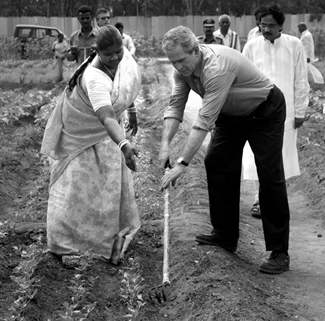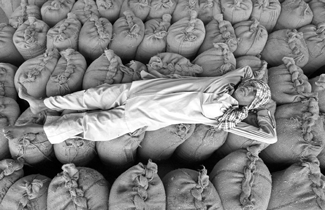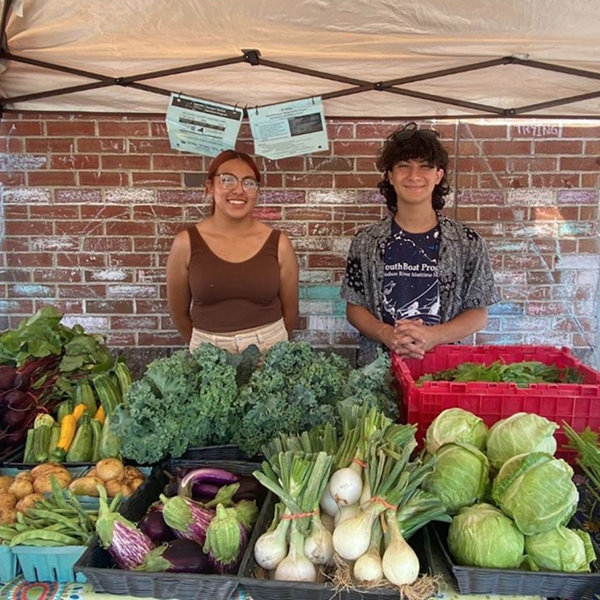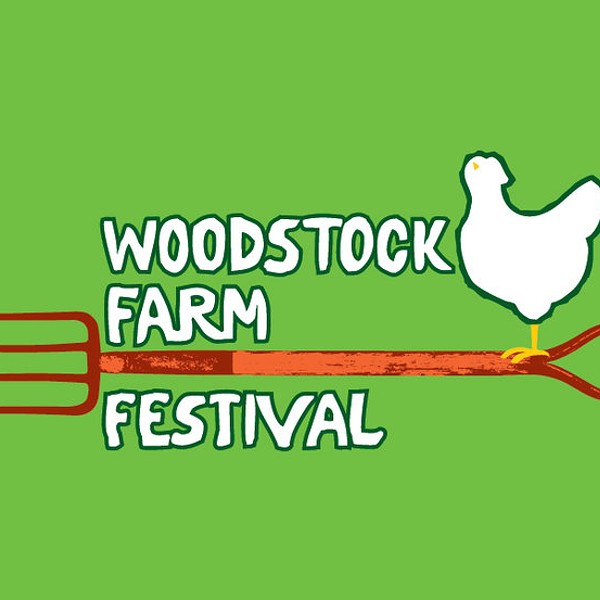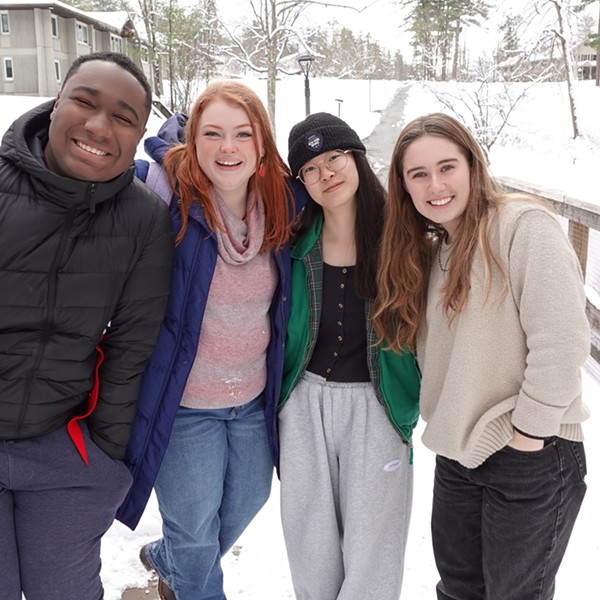Shiva originally gave this speech at Emory University in Atlanta on October 17, 2006. It was later broadcast on Alternative Radio (www.alternativeradio.org).
Being aware of the full cycle of life and its replenishment, what better opportunity than food? Food is in its very nature the place where ethics begins, because it is what connects us—our bodies—to the rest of the environment. Every other issue we can kind of put aside and think in a distant kind of way, but food becomes us. We are what we eat. So eating is the ultimate ethical act. It is the ultimate political act. It is the act where we decide whether we’re going to be part of raping the planet, killing the farmers, killing diverse species, and destroying our health in the process too; or we will be part of the protection of species, protection of the atmosphere, the protection of the annadatas, the givers of food. In Sanskrit, food is anna, data is the giver. The annadata is today in every society, beginning with this country, a threatened species.
In 1942, [India] had the great Bengal famine. It killed two million people, not because we didn’t have enough rice but because the rice that was grown was being taken out to feed the British army for the war. Half of what people grew was by force taken away as revenues by the British Empire. And when the famine started, it was the women of Bengal who started this amazing movement called Tebhaga. On one of my trips to Bengal, I was in a village hall, and the murals on the wall were paintings of this movement, where the women are standing there in front of their rice with brooms. That’s their defense. And on the other side is the police with guns. They are saying, “We will give our lives, but we will not give our rice.”
That’s what started to trigger land reform. The independence movement got accelerated. Nineteen-forty-two was the year we said to the British: Quit India. The Quit India movement began, and a series of things happened. But the most important outcome of it was the recognition that those who till the land must be the ones who make decisions about the land, must be the ones who benefit from the produce of the land. And out of that famine condition the rural areas became the driving force of the Indian economy. Half of the people who came 20, 30 years ago to Silicon Valley had been financed by parents from rural incomes, something that is usually forgotten—that you could send your child to university and college being a farmer, in this country as much as in India. My own mother financed my education with her farm income.
That changed in two steps. The first step, of course, was this 1965 revolution called the Green Revolution. Nineteen-sixty-five was a year of drought, a little less rainfall, just a little more import of wheat needed. We were told by the US: “We will not send you more wheat until you change your agriculture and adopt chemicals and the new seeds.” The World Bank came into the picture. And even though our prime minister of that time, Lal Bahadur Shastri, said, “We cannot experiment on such a large scale with so many lives,” we were literally compelled, through conditionalities, to adopt chemical agriculture. And it was adopted in the state of Punjab. That was just 1965-66.
By the 1970s, Punjab had become a volcano. By the early 1980s, it had become a center of terrorism and extremism. By 1984, the Golden Temple, an important Sikh shrine, had been attacked. As a backlash, Indira Gandhi was assassinated that winter. It was also that year, one month after Indira Gandhi’s assassination, we had Bhopal, the Union Carbide chemical disaster that has killed 30,000 people since then. Punjab’s violence and terrorism has killed 30,000 too. By the end of that year, I was holding my head and saying, “The Green Revolution got a Nobel Prize for peace. Where is this peace? And what was the Green Revolution?”
The Green Revolution
I’m a physicist. I had no idea what they were doing in agriculture. A year spent trying to figure out what the Green Revolution was taught me two very basic facts about industrial agriculture and chemical agriculture. First, that it was really about converting weapons of mass destruction into products for our food system after the wars. When the markets dried up for selling chemical weapons and for making explosives from nitrogen, then the markets grew for nitrogen fertilizers, for pesticides. The Green Revolution was crafted to make that market grow.
It was a remodification of plants—especially in the Indian context, of the rice and wheat varieties—to let them adapt to chemicals. Chemicals applied for nitrogen lead to more chemicals needed for pest control, more chemicals needed for weed control. And it is never ending.
The second thing I learned about the Green Revolution, by just doing very basic arithmetic, was that we had been tricked to believe we produced more food. Yes, we produce more rice and wheat. But food is not just rice and wheat. If you are a bhat- [rice] eating Bengali or a south Indian, you need your sambal [chili relish] and you need your dhal [lentils]. And if you are from the northwest then you need your roti [flat bread] and your dhal. And you do need some mustard oil and sesame oil to give that nice flavor and spice to your food.
The Green Revolution got rid of the pluses, rid of the oil seeds, rid of the greens, and in fact brought more land under rice and wheat. We’ve done calculations that show that the increase in rice and wheat can be 100 percent explained by increase in land under rice and wheat and increased irrigation to rice and wheat. You could have achieved the same amount of increase in rice and wheat without chemicals and without new seeds. So we were led to believe there was a technological miracle taking place.
On the basis of 20 years of my work and studies in different ecosystems of India, whether it be the home gardens of Kerala or it be small terrace farms in Uttaranchal or the desert of Rajasthan, everywhere we have been able to show that with ecological inputs and biodiversity on your farm, you double and triple production of food, and you can take incomes to the skies, depending on what crops you choose.
So the idea that you have to introduce more chemicals and you have to introduce miracle seeds to increase productivity and to make rural incomes grow is not just not true, it is a blatant lie. I’m not used to using strong words unless they’re absolutely necessary, and in the area of food they are, because our ignoring this lie is what is leading to the genocide of farmers.
The seeds of suicide
In India, building upon the Green Revolution, we have globalization and the Second Green Revolution. That’s the name being given to genetic engineering. For those of you who are not familiar, the term Green Revolution and the technology package were introduced because there was a Red Revolution spreading at that time and there was panic. So they said, “How do we create prosperity through technology that will make rural areas so prosperous that through the prosperity will come peace and they will not need to have any social change?” The word “green” was mainly applied because it was about agriculture, not because it was green in philosophy. I have called it the Anti-green Anti-revolution.
The Anti-green Anti-revolution is being accelerated through genetic engineering. The Green Revolution was driven by the World Bank, the US government, state agencies, state research organizations—an entire system of matching high-cost production with distributing food at affordable prices, the amazing system of public distribution that was created in India to make it all happen. The genetic engineering revolution is being driven by global corporations. The World Bank is always willing to help of course. It never needs too much of an excuse to push the world somehow into the wrong direction. The trade agreements, the World Trade Organization, has a very big role in it, and, as the WTO collapses, there are new bilateral arrangements.
You might have heard about the US-India nuclear agreement. But behind it is a more serious US-India agriculture agreement called, humbly, the Knowledge Initiative in Agriculture. The Knowledge Initiative in Agriculture has on its board, guess who? Name your three favorite companies in the food system:Monsanto, ADM, and Wal-Mart. Because it’s about integrating an industrial system from the seed to retail. What does the Monsanto miracle mean for India? It means genetically engineered cotton seeds. We have been effective so far in preventing any GM crop from coming into the food system, but every plant is food for some species.
The economics of it is what has become genocidal. Monsanto sells the seeds of [GM] cotton for 3,000 rupees a kilogram. It costs 3,500 rupees a kilogram. It just costs Monsanto 500 rupees to produce those seeds. The remaining 3,000—and for those of you who are wondering, it’s about 45, 47 rupees to a dollar—they collect as royalties.
Why do they collect it as royalties? Because now, with the World Trade Organization and with changes in US law, beginning with the 1980 decision in the case of General Electric and the application on a small microorganism, there has been this assumption that you can now treat life as an invention. Seeds, therefore, can be treated as the patented property of corporations. And if they are the patented property of corporations, you basically treat the farmer as someone who has borrowed your technology and has to pay a license fee and royalty for it, when all that the farmer has done is continued to do what is their duty, which is to grow seed out from the last crop.
The farmers are getting squeezed. Indebtedness is a surprise for your hard-working Indian farmer, who 10 years ago with that same hard work could send their children to college and school. Sixty percent of rural debt in India is for capital costs of purchase of external inputs, which is high-cost seed and high-cost chemicals, neither of which is needed. That unpayable debt is being imposed on a society where working with the land, which is something you could imagine yourself doing and generations doing, overnight has become unviable. I call it the negative economy. Suddenly the positive work of cooperating with the land has become a system of debt creation.
Nineteen-ninety-seven was the first farm suicide in the hybrid cotton areas. It has kept escalating. This year we hit the 140,000 mark. One hundred forty thousand farmers have committed suicide. Ninety percent of them committed suicide by drinking the same poisons that had got them into debt—pesticides. The women would say, “Spray peeliya,”—[they] drank the spray. So we are talking about a genocide that has no stoppage unless we change our food paradigm.
The industrialized food system
India currently is totally self-sufficient in wheat. We harvest wheat in March and April. We grow 72 to 73 million tons. But on March, 1, 2006, President Bush visited us. President Bush signed, as I mentioned, with our prime minister in July 2005 this agreement on agriculture. One of the commitments made related to his visit was we would start importing wheat we do not need to import. So the first thing was to liberalize imports. But the [American wheat from] Cargill and ConAgra and ADM was so bad that the Australians got the first bid. But the second time around they diluted the standards: higher pesticide residues, more weed contamination, more fungal disease.
We have now imported 5.5 million tons. We are importing wheat at 13,000 rupees a ton. Two-hundred-and-seventy dollars has become the international price. Domestically, Indian farmers were paid 6,000 rupees. And if they had been paid 8,000 rupees, everything would have been taken care of. But we are paying double to import. The price of wheat in the market has risen. Farmers are still getting a low price. The USDA is announcing India will need to import nine million tons. That’s more than a tenth of what we produce. You can see the vicious cycle start. The farmers won’t be able to sell next season. The markets will have collapsed. So the farmers will get less and less and less and the poor will pay more and more and more.
This polarization of prices is another mystery in the globalized, industrialized food system. The more farmers earn less, the more the poor pay for food, because the farmers don’t get the money. Somewhere in the middle it’s disappearing. My assessment is at this point farmers are not even earning 1 percent, they’re earning negative incomes. That’s what we have to turn around with local initiatives, wherever we are, to create a fair agriculture, a just agriculture, a sustainable agriculture. And a sustainable and just agriculture is the same kind of agriculture that protects our biodiversity and produces more food.
That’s the most important issue to remember. By practicing sustainability, we are not producing less, we are producing more. We just have to count in a different way. We have to get rid of our monoculture blinkers and bring biodiversity into our lens. We have to be able to count biodiversity and the benefits of biodiversity. Biodiverse systems produce more biodiversity. And we need more biodiversity both for sustainability, because it’s the biodiversity that produces the alternatives to toxins and fossil fuels. It’s the biodiversity that allows you to control pests. It’s the biodiversity that gives you the manures. Whether it’s green manures or compost, et cetera, it’s the biodiversity that allows you to do a better job of controlling weeds and pests, and bringing back soil fertility.
The health bomb
Biodiversity is also the basis of health. There are nutritional studies around the world now showing that the biodiverse diet is the place where the health crisis will be solved. We have currently, out of this industrialized, globalized system, a dual health crisis. I call it the health bomb. The first is malnutrition, the people who are hungry, a billion now permanently hungry. And something that’s not usually noticed—the fact that the hungry people today are the producers of food. The hungry people earlier used to be urban poor. Today the hungry people are growers of rice who have used chemicals to grow rice, who have taken on debt, have to sell the rice to pay back the credit, and starve themselves. Also because of that polarization of prices, when the farmer sells, he sells at a quarter the price of what he has to pay to buy that same rice back to feed, usually again on debt. The billion people hungry today are hungry because either they have been trapped in this high-external-input agriculture that creates debt or because they’ve been removed from their land.
The grabbing of farmers’ lands for creating special economic zones is the top political crisis of India today. These are foreign territories within India to be able to supply cheap products to the Wal-Marts because there will be no labor laws, no taxes, energy will be free, water will be free. Farmers are saying, “But we don’t want to give our land.” I call it the big land grab. But when you have less fertile land and you have fewer farmers to produce food, you can have the illusion of pseudosurpluses but you actually have real scarcity, too.
And on real scarcity, I want to just mention, there is at this point an assumption that we have a huge amount of food. But we have a huge amount of soybean, we have a huge amount of corn. It’s so much that most of it is going to feed animals in factory farms. And now, when we’re running out of fossil fuel, they’re saying we’ll use it to run our cars. It’s not the way that hunger will be solved. Hunger will be solved by having enough food in every ecosystem, in every community, and having large enough numbers to grow that food.
We’re often given the example of the US as the ultimate model, where less than 2 percent of people feed the world. First of all, it’s not just that 2 percent that’s feeding this country. It’s the peasants in Latin America, Africa, Asia who are providing food to you. This is always forgotten. You are providing forced trade, like the wheat imports to India. And that’s because US foreign policy decided long ago, from the Vietnam War days, that food would be used as a weapon. The use of food as a weapon means the cereals are kept under control, but for everything else you are importing. You are importing your fruits, you are importing your vegetables. And if you really did the sums of your food basket, the US is a hugely food-dependent country. But there is this illusion that it’s a food surplus country.
Some of us have given the name to this the great food swap, where the same thing is moving in two directions. And in every country exports are being subsidized and local is being punished, so that long-distance imports become cheap whereas local supply becomes costly. To build local food economies means cracking the second lie of cheap food. It is not cheap if you internalize the costs to the land, to the farmers, to the atmosphere, to biodiversity, and to public health.
Eating as an ecological act
I mentioned the billion who are hungry because of not having enough to eat. But the same system is giving us two billion who are suffering another kind of malnutrition, the malnutrition of the wrong kind of food—the kind of malnutrition symbolized so dramatically in that film Supersize Me. Obesity has become one of the biggest killers of our time, and it is totally linked to rotten food. I would call it nonfood. We are eating nonfood. We are eating things that are not worthy of being eaten.
In fact, there was a big international cultural congress in Spain, and I had to go talk about ecology. And I had a group of Vedic singers with me, brilliant, beautiful women, who did Vedic chants. And I had been asked to serve an organic meal, so they had carried our organic food from India, and we were going to cook an organic meal. So these women came to me and said, “Can you please give us some of that grain?” I said, “Of course. But why do you need it?” They gave me a word which I had no idea exists. They said, “The food here is abaksha.” I said, “What does that mean?” Baksha means worthy of consuming. Abaksha means unworthy of consuming. Our food has been rendered abaksha.
And I think the highest level of ethics is the ethics of recognizing that we are violating our own bodies, we are violating the sacred trust of our lives by bombarding ourselves with food unworthy of being called food. That’s why some of us around the world have said we need to move away from the language of being consumers, because, you know, the word “consumption” came out of tuberculosis in the Middle Ages. It was meant to describe that which kills. And our current food systems do kill. They kill the planet, they kill the farmers, they kill our health.
We need to move into another way of thinking, of eating as an ecological act, an ethical act, a political act, but a productive act. That in the very act of eating you are deciding how many species will live, in the very act of eating you are deciding whether the ice caps will melt and the sea will rise three meters or our coastal communities will have a chance, in the very act of eating you’re deciding whether creative people can work creatively with the land.
This figure of 2 percent feeding America, people try to apply that model to India. Seventy percent of India lives in rural areas linked to farming. They keep saying, “It should become like America, two percent.” I always say, “My God, this is going to be the second sea-level rise, because the only place to dump all the farmers is in the Arabian Ocean.” They’re not going to be IT software people.
I did a very rough calculation. If you add not just the people who actually work the land but you add the people who make the pesticides, you add the people who work in Monsanto’s labs, you add the people who work in the banks that give the loans, you add the people who drive these horrendous monsters on the highways called container trucks, blindly, miles and miles and miles, thousands of miles shipping food around, you add the Wal-Mart cash register people who are overexploited, if you add all of that, 50 percent of humanity will always be involved in making food possible, its production, its distribution.
We can either put 90 percent of that 50 percent in destructive work, in a food war, and have 10 percent working as farmers, or we can put the 100 percent of that 50 percent in the creative work of creating an ethical, sustainable food system.
This speech was originally broadcast on Alternative Radio; www.alternativeradio.org.







